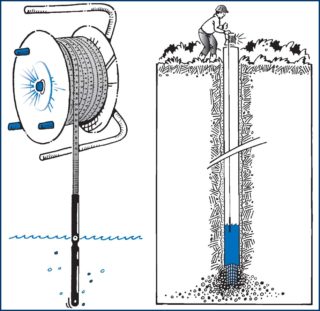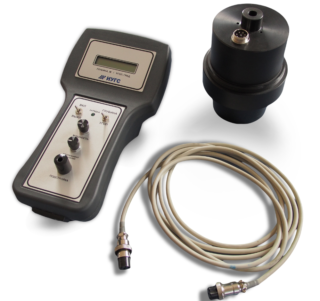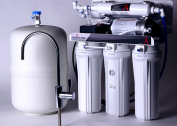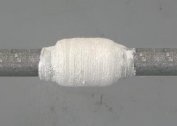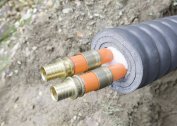Not only the cost of the work done, but also the quality of the water raised to the surface depends on the depth of the well for water. As a rule, the fundamental factor that forces the owners to monitor this parameter is the high cost of the work. For each meter, a fixed amount is required. If the work on the site is carried out independently, the depth of the well must be known for the correct choice of pumping equipment.
Methods for determining well depth
There are still no ways that with a 100% guarantee will allow you to establish the exact depth of the water before drilling. Even attracting a geophysicist to a personal plot with all the equipment will not be able to help.
To know the depth of the well after drilling you need:
- source passport;
- rope;
- pumping system;
- weighting material for immersion meter;
- measuring tool.
The presence of a passport will allow you to navigate in the approximate parameters of the well. It also contains information about the level of location of drinking water, the border of the maximum liquid filling, indicators of the depth and diameter of the casing. In the absence of a document, measurement will be more difficult.
Work order
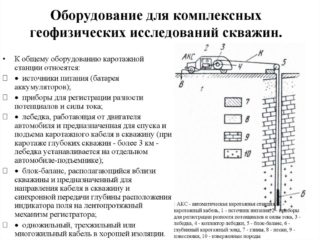 In order to measure the depth of the well after drilling with the smallest error, measurements must be carried out at a certain air temperature and at a certain time of the year. Most preferably the second half of summer if the weather is dry.
In order to measure the depth of the well after drilling with the smallest error, measurements must be carried out at a certain air temperature and at a certain time of the year. Most preferably the second half of summer if the weather is dry.
Work on measuring the depth of the well is carried out in several stages:
- Measure the radius of the hole.
- Attach a weighting agent to the lowering end of the rope.
- Submerge the rope in the well until it becomes noticeable that it has touched the bottom.
- After pulling the rope, determine the water level and the actual depth of the well.
Using this method, it is possible to calculate the statistical depth parameters. There is another concept - dynamic indicators. To measure them, pumping units are used. The process itself does not require special skills and does not take much time. Using pumping equipment, all water is pumped out of the well, and then the rope is lowered for measurements. At the bottom there will always be a small amount of water, the distance to it will be an indicator of dynamic depth.
Using a pumping station, a filter screen must be put on the hoses to be immersed. This will prevent dirt from entering the pump.
Determination of the required drilling depth
The depth of well drilling can be calculated as follows: when the drilling rig reaches the first aquifer, water samples are taken and sent for examination. If the composition does not contain harmful impurities and a high concentration of solid particles, work can be stopped. If the indicators are not normal, continue to increase the depth.
Wireline measurement
You can measure indicators yourself in a fairly simple way. You need to purchase or rent a logging cable with magnetic tags, which are located at a certain interval. They allow you to see all the necessary information about the well.
The top of the cable is equipped with a screen that displays the actual data. If the cable touched the bottom, and the interval between the marks is displayed on the surface, the indicators will automatically be displayed.
Acoustic depth gauge
The technology for using the device is extremely simple, in addition, this method is one of the most accurate. You do not need to purchase it, you can rent it.
The fixture directs inward signal waves. They are reflected on the bottom and come back to the surface.Entering the obtained indicators into the given formulas, all the technical parameters of the well are calculated.
How to check old wells
Buying a house with an artesian well already located on the site, documents to which are not attached, most likely, you will have to equip a new well. This is due to the fact that the repair of old water sources is impractical. This is not only financial, but also time-consuming. It is possible that its service life has long come to an end, garbage and stones have collected during the downtime, casing pipes are torn, etc. This problem is especially common when it comes to sand wells.
To restore the source, you will need to pay for logging, purchase a submersible pump, which will try to pump out the contents. If the casing pipe is broken, there is a possibility that the equipment will catch on it. It will only be possible to verify the well’s working capacity by experience. If the result does not please, it will be necessary to start drilling again on the site.
Can I believe the data in the passport
If specialists from the drilling company were engaged in the work process, a technical passport is attached to the well, in which all the main parameters are fixed. Is it possible to 100% believe the indicated data, it is impossible to answer unequivocally.
As a rule, when choosing specialists, they look at their professionalism and reputation. No self-respecting enterprise will deliberately add extra meters in order to benefit for themselves. Therefore, it is strongly recommended to give preference to experienced and trusted professionals. If possible, you yourself should be present during the drilling operations.
Self-counting while drilling is easy. In the process, special units equipped with rods are used. The greater the depth, the more rods are used. When using a small-sized drilling rig, the calculation is made after completion of work.
Conducting a water supply system in a country or private house, many factors are taken into account. For example, rock hardness, soil section, the nature of aquifers, water quality, etc. It is possible to independently carry out drilling work, but provided that the depth of groundwater is small and the requirements for the quality of the water used will be small.
If you need high-quality water when conducting an autonomous water supply system, you need to seek professional help. It is recommended not to save in such matters, as this may lead to the opposite result.
